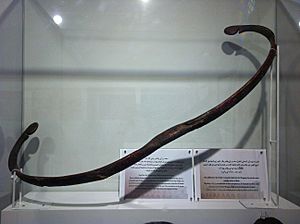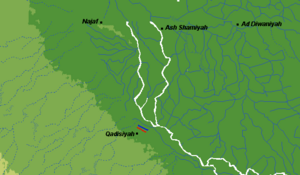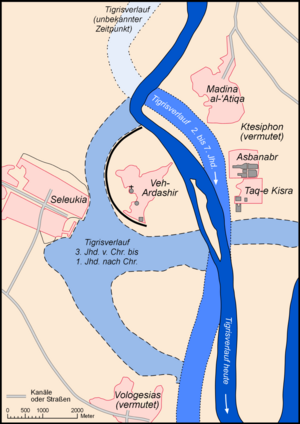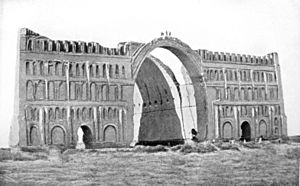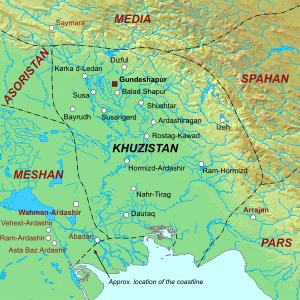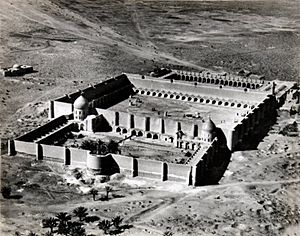Sa'd ibn Abi Waqqas facts for kids
Quick facts for kids
Sa'd ibn Abi Waqqas
سَعْد إبِن أَبِي وَقَّاص |
|
|---|---|
| Native name |
Arabic: سَعْد ابِن أَبِي وَقَّاص ابِن وهَيْب الزُّهري, romanized: Saʿd ibn Abī Waqqās ibn Wuhayb al-Zuhrī
|
| Other name(s) | Abu Ishaq |
| Born | c. 595 CE Mecca, Hejaz, Arabia (present-day KSA) |
| Died | c. 674 (aged 78–79) Medina, Hejaz, Umayyad Caliphate (present-day KSA) |
| Buried |
Al-Baqi Cemetery, Medina
|
| Allegiance | Muhammad (610–632) Rashidun Caliphate (632–644) |
| Service/ |
Rashidun army |
| Years of service | 624–644 |
| Commands held |
|
| Battles/wars |
|
| Spouse(s) | Salma bint Khasafah Makhita bint Amr |
| Children |
|
| Relations | Banu Zuhrah (Clan) |
Saʿd ibn Abī Waqqāṣ (Arabic: سعد إبن أبي وقاص), also known as Saʿd ibn Mālik, was a close friend and follower of the Islamic prophet Muhammad. He was a brave military leader who helped conquer Persia and founded the city of Kufa. Saʿd was one of the first people to become a Muslim, doing so at the age of seventeen. He fought in all the battles with Muhammad while they lived in Medina.
Sa'd is famous for leading the Muslim army in the Battle of al-Qadisiyyah and for capturing the Persian capital, Ctesiphon, in 636 CE. After these victories, Sa'd became the top commander of the Rashidun army in Iraq. He helped conquer the Khuzestan area and built the important city of Kufa. Later, he was replaced by the caliph Umar due to some complaints. During the First Fitna, a civil war among Muslims, Sa'd chose to stay neutral. Many other important companions of the Prophet and their followers also chose not to take sides because of his influence. Some stories from Chinese Muslims say that Sa'd introduced Islam to China in 651 CE during a diplomatic trip, but this is debated by historians.
Sunni historians and scholars highly respect Sa'd. This is because he was a close companion of Muhammad, was one of the ten to whom Paradise was promised, and fought in the Battle of Badr. People who fought in the Battle of Badr are especially honored in Islam.
Sa'd's Early Life and Faith
Sa'd was one of the very first people to accept Islam. He was seventeen years old when he became a Muslim. Some historians say he was nineteen. It is believed that Abu Bakr, a close friend of Muhammad, invited Sa'd to Islam.
Sa'd's mother was very upset when he became a Muslim. She threatened to go on a hunger strike (stop eating) until he left Islam. But Sa'd was firm in his new faith and did not give in. His mother eventually gave up. It is said that Muhammad told Sa'd that God praised his strong faith. However, Muhammad also told Sa'd to be kind to his mother, as respecting parents is very important in Islam. Sa'd's brother, Amir, also became a Muslim, which led to another hunger strike from their mother, but it also failed.
In Mecca, Sa'd and other Muslims were once insulted by a group of people who did not believe in Islam. Sa'd reacted by hurting one of them with a camel bone. This event is sometimes called "the first blood to be shed in Islam."
Before Muhammad moved to Medina, Sa'd traveled there with Ibn Umm Maktum and Mus'ab ibn Umayr. He continued to practice Islam in Medina.
Life in Medina and Early Battles
When Sa'd and his family arrived in Medina, they quickly promised their loyalty to Muhammad. The Muslims who moved from Mecca were called muhajirun, and the local people of Medina were called the Ansar. In Medina, Sa'd took part in most of the military actions against the Quraysh tribe from Mecca.
Sa'd's first mission was about nine months after the move to Medina. He led 20 men to raid a Qurayshi trade caravan. This mission was not successful, as the caravan got away.
Later, during a small scouting mission, Sa'd and his team were chased by Qurayshi fighters. Sa'd and his group ran away. Some stories say Sa'd shot arrows while retreating. His team returned safely to Medina. Sa'd was proud that he helped the Muslim scouts survive.
The Battle of Badr
Before the Battle of Badr in 624 CE, Muhammad sent Sa'd, Ali, and Zubayr ibn al-Awwam to scout the enemy. The Muslim army had originally planned to capture a rich trade caravan, not to fight the main Meccan army.
Sa'd was known for his archery skills. During the Battle of Badr, the Muslims fought in a tight formation. A story says that Sa'd prayed for his arrow to hit the enemy, and Muhammad also prayed for him. Sa'd's archery skills caused problems for the enemy. He also fought in close combat when the Muslims started winning. Sa'd killed a Qurayshi champion and took his sword as a war prize, which he gave to Muhammad. He also captured two Qurayshi soldiers.
Later, historians called Sa'd the "first Muslim archer." Sa'd's younger brother, Umayr, wanted to fight in the battle, but Muhammad first said no because he was too young. Umayr kept asking and was finally allowed to fight, but he died in the battle.
Protecting Muhammad at Uhud
At the Battle of Uhud, Sa'd was part of an archer group. The Muslim army was winning at first, but then they were surprised by an attack from the side by Khalid ibn al-Walid. The Muslim forces scattered, and Muhammad was left with only about a dozen men. Sa'd was among them, along with Talha, Abu Dujana, and a few others.
The small group was surrounded by enemy horsemen. The Muslims formed a tight defense. Sa'd shot his arrows near Muhammad, who was injured in the shoulder. The outnumbered Muslims fought bravely until most were killed. Only Muhammad, Talhah, Abu Dujana, and Sa'd remained. Sa'd kept shooting arrows, even in the close fighting. He even fired multiple arrows at once.
Muhammad saw how effective Sa'd was. He gathered arrows for Sa'd and stood next to him while Sa'd kept shooting. This allowed the surrounded Muslims to escape. Muhammad praised Sa'd for his actions.
After they escaped, Muhammad killed one of the remaining enemy pursuers. Sa'd then promised to kill his own brother, Utbah ibn Abi Waqqas, who was fighting for the enemy. Utbah had injured Muhammad during the battle.
After Uhud and the Ridda Wars
Sa'd became a member of Muhammad's personal bodyguard unit, called the Haras. When Muhammad and his wife Aisha went on military trips, Sa'd guarded their tent at night.
Sa'd was also an important member of the Muslim community in Medina. He took part in the Pledge of the Tree, an event praised in the Qur'an. On the same day, Sa'd also saw the signing of the Treaty of Hudaybiyyah. This treaty created a peace agreement between Medina and Mecca. Sa'd participated in all battles with Muhammad until the Expedition of Tabuk. These included the Battle of the Trench, the Siege of Khaybar, the Conquest of Mecca, and the battles of Hunayn and Awtas.
When Muhammad died, Abu Bakr became the first caliph (leader of the Muslim community). The Ridda Wars then broke out across the Arabian Peninsula. Abu Bakr sent his best forces to calm the northern border. He gathered the rest of the army, including Sa'd, to fight rebels. Sa'd joined the army that marched to crush rebels in Dumat al-Jandal.
The Conquest of Persia
In 636 CE, after Umar became the second Caliph, he sent Sa'd to lead an army to Iraq. This was to help in the Muslim conquest of Persia. Umar gathered 12,000 soldiers in Medina for Sa'd's army. Before they left, news came that the previous Muslim commander in Iraq had been killed. So, Umar changed his plans. He told Sa'd to march to Iraq with 6,000 soldiers. He also ordered other Muslim armies in Iraq to join Sa'd. Sa'd gathered more soldiers as he marched, eventually having 30,000 troops.
The Persian commander, Rostam Farrokhzad, led a huge army to fight the Muslims. He marched slowly, hoping to make Sa'd's army impatient. However, Sa'd was advised to stay near the desert and not go too deep into Persian land. Sa'd agreed and followed this advice.
Sa'd regularly sent messages to Umar in Medina, reporting everything that happened. Umar told Sa'd not to attack first.
Before the Battle of Qadisiyyah
Before the big battle, Sa'd tried to use psychological warfare. He sent messengers to challenge Rostam.
First, he sent Asim ibn Amr al-Tamimi. Rostam gave Asim a basket of dirt. Asim cleverly said that this meant the Persians had agreed to give their land to the Muslims. He then returned to Sa'd to report.
Next, Sa'd sent al-Mughira. He offered Rostam three choices: become Muslim, surrender peacefully, or fight. Al-Mughira even broke a sword given to him by Rostam to provoke him.
For the last messenger, Sa'd sent Rib'i ibn Amir, a tough Bedouin leader. Rib'i entered Rostam's tent with his mule, making the carpet dirty. This shocked Rostam's court. Rib'i gave Rostam the same three choices: accept Islam, pay a special tax (jizya), or war. Rib'i said his leaders would only give Rostam three days to decide. Sending Rib'i made Rostam lose his patience, and he prepared his army for battle.
As Rostam's army marched, Sa'd sent scouts, led by Tulayha and Amr ibn Ma'adi Yakrib. They went deep into Persian land to gather information. They found the first part of the Persian army, estimated at 70,000 soldiers. Tulayha and Ibn Ma'adi sent the scouts back to Sa'd, while they continued scouting. They found the second and third parts of the army, which they believed were 100,000 and 70,000 strong.
Tulayha even snuck into Rostam's camp at night. He cut tent ropes and started fires, causing chaos. He took two horses and a captive back to Sa'd. The horses, Tulayha said, belonged to Rostam.
The Battle of Qadisiyyah
The Battle of Qadisiyyah is very important in Islamic history because it marked the fall of Persia to the Muslim army. However, old Islamic writings do not give many details about the battle itself. They focus more on heroic stories of fighters. Modern historians believe many details are exaggerated. The exact date of the battle and the size of the armies are also different in various sources. Historians agree that the Persians had more soldiers. The battle likely happened in 636 or 637 CE.
One thing all stories agree on is that Sa'd himself was not on the battlefield. Some say he had hemorrhoids or smallpox. They also agree that the enemy commander, Rostam, died.
Here is a common story of the battle, based on old writings:
- Day 1: The Day of Armath Asim ibn 'Amr led the first fight. The Persians sent their heavy cavalry and elephants, causing problems for the Muslims. Sa'd, watching from his tent, ordered Asim to deal with the elephants. A special group of cavalry, trained to fight elephants, attacked the biggest elephant. By the end of the day, no elephants were left, and the Muslim army had stopped the Persian cavalry.
- Day 2: The Day of Agwath The Muslims continued fighting. Suddenly, al-Qa'qa ibn Amr, a skilled warrior, arrived and attacked the Persian right wing. He killed their commander, Bahman, leaving that part of the Persian army without a leader. It is said that al-Qa'qa fought in 30 personal duels that day.
- Day 3: The Day of Imash The elephants returned to the battlefield, making the situation difficult for the Muslims again. Sa'd sent urgent messages to focus on the elephants. Al-Qa'qa ordered large camels to attack the elephants' sides, while spearmen formed walls in front of them. Many elephants were killed or ran away, trampling their own soldiers. The commander of the elephant corps fled. Sa'd ordered his men to chase and kill him to make sure the elephants were no longer a threat. A Muslim horseman chased and killed him.
- Day 4: The Day of al-Qadisiyyah Rostam's death shocked the Persians. Sa'd ordered a full attack. A heavy sandstorm blew towards the Persian army. Rostam was hiding near a camel when weapons fell on him, breaking his back. A Muslim soldier found him and killed him. Other stories say different soldiers found his body.
After Rostam's death, the Persian forces broke and fled towards a river. Muslim archers attacked them, causing many casualties. The Persians were completely defeated.
News of the victory spread, and many cities that had rebelled against the caliphate surrendered again. Sa'd immediately sent news of his victory to Medina, where Umar told the people about it.
Crossing the Tigris and Capturing Ctesiphon
Soon after the victory at Qadisiyyah, Sa'd led his army to capture the Persian capital, Ctesiphon. He organized his army into five groups. The first group marched north. As they reached Borsippa, they defeated the remaining Persian army. Sa'd's forces then easily defeated another Persian army. They continued marching and defeated more Persian resistance.
Sa'd's army then reached Bahurashir, a suburb of the Persian capital. Sa'd used this city as his military base. He sent small groups to gather information. These groups found no enemy forces but took money from local farmers. Sa'd told Umar about this, and Umar replied that taking money was forbidden. He told the soldiers to offer people a choice: become Muslim or pay a special tax (jizya). Sa'd sent Salman the Persian to offer these choices. Most locals accepted, but the people of Bahurashir resisted behind their walls.
Sa'd besieged Bahurashir and built 20 trebuchets (large war machines) to attack the city. The city's defenders tried to stop the trebuchets but were pushed back. The siege continued until the defenders ran out of supplies. They left Bahurashir and crossed the Tigris River to Al-Mada'in. Sa'd then entered the empty city.
The Tigris River was very high and fast, making it impossible to cross without boats. Sa'd was frustrated because he heard that the Persian king, Yazdegerd III, was moving his treasures from Mada'in to another city. That morning, Sa'd decided to take a risk. He told his army to cross the river with their horses, despite the strong current. Sa'd believed they needed to capture Mada'in quickly to prevent Yazdegerd from using his wealth to build another army.
The soldiers were hesitant, but Sa'd encouraged them. One by one, they plunged into the river and crossed. The Persians in Al-Mada'in castle were shocked, yelling, "Crazy! They are crazy!" They tried to stop the crossing with their cavalry, but the Muslim archers shot their horses' eyes, making them run wild. The Persians abandoned their horses and ran away. By the time they reached the Persian capital, Sa'd had recovered from his sickness.
The Wealth of Yazdegerd
Once the army crossed the river, they chased the Persians who had fled to Madain. But they could not find them. Yazdegerd had moved his family and most of his belongings out of the city. The Muslim army captured Al-Mada'in's treasury. They also found Yazdegerd's crown and robe in a sack on a mule. These were immediately taken and brought to Sa'd.
The palace was empty. Sa'd sent Salman to teach Islam in the captured city. In the month of Safar, Sa'd gathered his troops to perform the Friday prayers in the palace. This was the first Friday prayer held in Iraq. Sa'd planned to live in this palace. He appointed a manager for the war spoils and Salman to give one-fifth of the spoils to the soldiers. Because the army had many horsemen, each soldier received at least 12,000 silver dirhams. The rest of the wealth was sent to Medina.
When the Persian wealth reached Medina, Umar gave Yazdegerd's golden bracelet to Suraqa bin Malik. This was because Muhammad had promised Suraqa Yazdegerd's bracelets during the Hegira (the migration to Medina).
Governor of Kufa
After Sa'd conquered Al-Madain, Umar ordered him to make the conquered area stable before chasing the Persian forces that had fled to the mountains.
Sa'd heard that people in Mosul had gathered at Tikrit under a leader named Al-Antioch. Al-Antioch had gathered Byzantine allies and Arab Christian fighters. Sa'd wrote to Umar about this, and Umar ordered him to attack Mosul first. Sa'd sent an army to Mosul. After defeating the enemy in Tikrit, the Muslim forces captured Nineveh and Mosul, making them pay the jizya tax.
As Yazdegerd fled to Hulwan, he gathered over 100,000 soldiers and appointed Mihran as their commander. Yazdegerd raised this huge army because he could not accept his defeat at Al-Qadisiyyah. Mihran's army dug a large ditch for defense. Sa'd asked Umar for more instructions. Umar told Sa'd to stay in Al-Madain and send Hashim ibn Utbah to attack Jalula. Sa'd followed these orders. The Muslim troops sent to Jalula numbered 12,000, including experienced warriors. It is said that the Muslims captured huge amounts of treasure, weapons, gold, and silver from this battle, almost as much as they found in Al-Madain.
After the battle in Jalula, Umar ordered Hashim ibn Utbah to stay there. Al-Qa'qa continued to chase Yazdegerd to Hulwan. Al-Qa'qa fought another Persian force in Hulwan and personally killed their commander. Yazdegerd continued to raise more forces. Sa'd's troops chased them and defeated them in Ahvaz. The large amount of war spoils became a problem for Sa'd. Complaints reached the caliph about how Sa'd distributed the spoils from Jalula. This led Umar to call Sa'd back for questioning and start an investigation.
Founding the City of Kufa

After the Arab armies settled in Al-Madain, Umar learned that many soldiers were getting sick. The soldiers said they were sick because the place was "not fit for camels." Historians think the soldiers were not used to the non-desert climate of Al-Madain, which was a large city with many trees. Umar sent Ammar ibn Yasir and Hudhayfah ibn al-Yaman to help in Iraq and find better places for the army to settle.
Sa'd moved to what would become Kufa. He took down walls and military buildings from Al-Madain to build a new garrison city, or misr. The new city was called Jund al-Kufah. It was a place for Muslim soldiers and their families to live permanently. Sa'd made Kufa his main headquarters.
In Kufa, Sa'd ordered Hashim ibn Utbah to lead his forces to Khuzestan to fight Hormuzan, a Persian commander who survived the Battle of Al-Qadisiyyah. They won the battle, and Hormuzan fled. Later, Umar learned that Yazdegerd was gathering another army to attack Basra. The caliph ordered Sa'd to send troops to Ahvaz to face this threat. This army successfully defeated the Persians and conquered most of Khuzestan.
Hormuzan again gathered Persian forces. Sa'd informed Umar, who sent another army. This force defeated the Persians and captured one of their commanders. Sa'd appointed a leader to manage the conquered area.
Umar then ordered troops from Kufa to help the army in Emesa, where Muslim forces were surrounded by a Christian Arab army. Sa'd sent several thousand horsemen as reinforcements. After the siege was lifted, Umar ordered the reinforcements to return to Iraq.
Sa'd's Dismissal
In 638 CE, Umar sent Muhammad ibn Maslamah to Kufa because he heard complaints about Sa'd. Sa'd had built a public fort next to his house. The market noise was so loud that Sa'd built a locked gate into the fort. Umar sent Ibn Maslama to destroy this gate, which he did by setting it on fire. Ibn Maslama refused Sa'd's hospitality and gave him a letter from Umar. The letter reminded Sa'd that the fort should be open to the public and suggested he move his house. Umar also sent spies to investigate Sa'd. They found that most Kufa residents supported Sa'd, except for two tribes.
In 642 CE, Ibn Maslamah was sent again to investigate more complaints. He visited mosques and listened to people. Most people were happy with Sa'd, but there was an accusation that he did not lead prayers correctly and spent too much time hunting. Ibn Maslamah took Sa'd and his accusers to Umar. Sa'd was found innocent, and the accuser was spreading rumors. However, Umar still replaced Sa'd as governor. Some historians say Umar wanted to avoid any possible scandals. He trusted Sa'd and found no wrongdoing. Other historians suggest the complaints came from jealousy among certain clans in Kufa who disliked Sa'd's high position and his closeness to his nephew, Hashim ibn Utba.
Later, before the Battle of Nahavand, Umar held a war meeting with Sa'd and other important leaders.
Some stories say that even though Umar removed Sa'd from his position, he recommended that the next caliph reappoint him. Umar said he did not remove Sa'd because of any wrongdoing. Later, Sa'd was one of six people chosen by Umar to be considered for the third caliph. Umar's will asked the third caliph to reappoint Sa'd as governor of Kufa. Uthman did this, replacing the current governor with Sa'd. Several years later, Sa'd had a disagreement with Abdullah ibn Masud over a debt. This led Uthman to remove Sa'd again and appoint a new governor.
The First Muslim Civil Wars
When the First Fitna (the first Muslim civil war) began, Sa'd convinced many important companions of the Prophet to stay neutral. These included Ibn Abbas, Abdullah ibn Umar, and Muhammad ibn Maslamah. Sa'd and others refused requests for help from the different sides in the war. Many people were unhappy with this neutral group led by Sa'd. They thought their inactivity prevented the conflict from ending quickly. Sa'd's own son, Umar ibn Sa'ad, was one of his critics.
Sa'd lived longer than all the other ten blessed companions. He died at the age of eighty, around 674 CE. Based on the last tax he paid, Sa'd's wealth was about 250,000 dirhams when he died.
Sa'd's Legacy
Sa'd had a long and important career in early Islamic history. He is remembered as a great military leader and a respected companion of Muhammad. Stories about him even influenced Islamic traditions in China. Sa'd's image as a hero of Islam was used by later leaders, like Saddam Hussein, to connect themselves to the conqueror of Iraq.
Islamic Teachings
Sunni Muslims consider Sa'd one of the ten to whom Paradise was promised. He is famous for fighting in the battles of Badr and Uhud. Some verses of the Qur'an are believed to have been inspired by him. For example, a verse in Sura Al-Ankabut is thought to be about Sa'd's strong faith. Another verse in Sura Luqman encouraged Sa'd to be kind to his parents, showing how important respecting parents is in Islam.
Many sayings (hadiths) are linked to Sa'd. Fifteen hadiths are found in important collections like Sahih Al-Bukhari and Muslim. The Musnad Ahmad ibn Hanbal contains 177 hadiths from him. Important narrators like Abdullah ibn Umar and Aisha also shared hadiths from Sa'd.
Some hadiths involving Sa'd are used to explain the Islamic law of inheritance. This law limits how much wealth a person can give to charity if they have heirs. This rule is mostly based on a story where a very sick Sa'd asked Muhammad for advice on how much wealth he should give to charity.
Sa'd earned some of his money through muzara'a. This was a business where the product was shared based on a fixed agreement, similar to sharecropping.
Buildings and Cities
Sa'd is known for founding the city of Kufa, next to Al-Hirah. The main roads of Kufa were wide. The city grew very important during Umar's time, who called it Ras Islam (Head of Islam). It was built as a permanent home for the Muslim army in Iraq.
Sa'd had many public buildings constructed in Kufa. He built a canal named after him and a large congregational mosque for Friday prayers. This mosque could hold 40,000 people. Its main building was located south of its prayer direction. The Kufa grand mosque later became historically important. It was where the Hasan–Muawiya treaty was signed, where Hasan ibn Ali gave up his position as caliph.
Some historians say Sa'd was the first to lead Friday prayers in Iraq. They say he turned the main hall of the Ctesiphon palace into a prayer area for the Muslim army.
Military Achievements
Islamic scholars praise Sa'd for his two most important battles in Iraq: the Battle of Qadisiyyah and the capture of Ctesiphon. The Battle of Al-Qadisiyyah marked the beginning of the caliphate's strong presence in Iraq. Almost all Iraqi cities that had rebelled when Khalid ibn al-Walid left quickly surrendered to Sa'd. Some stories say that Arab tribes in Yemen closely watched the outcome of Al-Qadisiyyah, believing it would affect them too.
After capturing Ctesiphon, Sa'd sent most of the huge war spoils to Medina. His army also seized a massive amount of wealth after the Battle of Jalula. This was considered the largest capture of wealth during the conquest of Persia.
Stories of a Visit to Asia

Many Hui Muslims in China believe that Sa'd introduced Islam to China. According to their tradition, Sa'd came to China as an ambassador in 650 CE during the rule of Emperor Gaozong of Tang. Some scholars even say he came earlier, in 616 CE.
However, whether Sa'd actually visited China is debated by historians. While some Chinese people claim to be his descendants, there are no clear records of such a journey by Sa'd in Arab historical texts. Historians note that Muhammad sent envoys to Persia and Ethiopia, but China is not mentioned. There is a famous tomb for Sa'd in Guangzhou, China, but there is also one in Medina, which is considered more likely to be his actual burial place. Some think these local traditions might be linked to early Muslim traders from West Asia who settled in Chinese coastal towns. Still, Sa'd is an important figure in the cultural heritage of Chinese Muslims, especially with the mosques and tombs linked to him.
In Central Asia, his name is often spelled "Saduakas" (Sadvakas). This is a very common name among the nomadic people there.
See also
 In Spanish: Sa'd ibn Abi Waqqas para niños
In Spanish: Sa'd ibn Abi Waqqas para niños
- Emperor Gaozong of Tang
- Al-Mughira
- Rashidun cavalry
- Sunni view of the Sahaba
- The ten to whom Paradise was promised
- List of Sahabah


